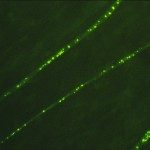Lien vers Pubmed [PMID] – 21805057
J. Neurovirol. 2011 Aug;17(4):353-67
Rabies virus (RABV) is a neurotropic virus transmitted by the bite of an infected animal that triggers a fatal encephalomyelitis. During its migration in the nervous system (NS), RABV triggers an innate immune response, including a type I IFN response well known to limit viral infections. We showed that although the neuroinvasive RABV strain CVS-NIV dampens type I IFN signaling by inhibiting IRF3 phosphorylation and STAT2 translocation, an early and transient type I IFN response is still triggered in the infected neuronal cells and NS. This urged us to investigate the role of type I IFN on RABV infection. We showed that primary mouse neurons (DRGs) of type I IFN(α/β) receptor deficient mice (IFNAR(-/-) mice) were more susceptible to RABV than DRGs of WT mice. In addition, exogenous type I IFN is partially efficient in preventing and slowing down infection in human neuroblastoma cells. Intra-muscular inoculation of type I IFNAR deficient mice [IFNAR(-/-) mice and NesCre ((+/-)) IFNAR ((flox/flox)) mice lacking IFNAR in neural cells of neuroectodermal origin only] with RABV reveals that the type I IFN response limits RABV dissemination in the inoculated muscle, slows down invasion of the spinal cord, and delays mortality. Thus, the type I IFN which is still produced in the NS during RABV infection is efficient enough to reduce neuroinvasiveness and pathogenicity and partially protect the host from fatal infection.

